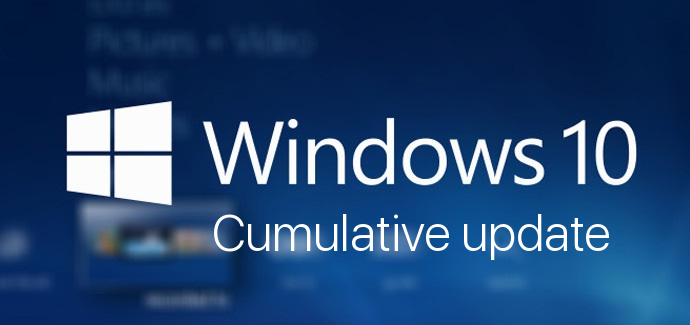Microsoft is releasing cumulative updates for Windows 10 version 1709 and 1703. Both updates include quality improvements only. They do not add new features to the OS, however, they change the build number. Here are the changes introduces in the updates.
Note: Click here to find which Windows 10 version you have installed.
Windows 10 version 1709 KB4499147 (OS Build 16299.1182)
- Addresses an issue with looping redirects between Microsoft Edge and Internet Explorer 11.
- Updates wininet.dll to prevent the re-creation of File Transfer Protocol (FTP) control sessions.
- Addresses an issue that prevents the OS from loading new icon files if it encounters an icon file that has a bad format.
- Addresses an issue to set the date separator properly in the Japanese short date format. For more information, see KB4469068.
- Updates time zone information for Morocco.
- Updates time zone information for the Palestinian Authority.
- Addresses an issue in which Windows attempts to renew Azure Active Directory (AAD) token certificates when there is no internet connectivity. This issue occurs during AAD authentication and slows the performance of applications.
- Addresses an issue that may cause a temporary KRB_AP_ERR_MODIFIED Kerberos sign-in failure in applications and services configured to use a Group Managed Service Account (GMSA). This issue occurs after the automatic update of the service account password.
- Addresses an issue that causes a sign-in to fail with the error, “Incorrect Username or password” when using an empty or null password and Windows Defender Credential Guard is enabled.
- Addresses an issue that causes Microsoft Office and other applications to prompt for a password after you change a user account password. This issue occurs on hybrid Azure Active Directory (AD) joined systems.
- Addresses an issue with BranchCache when it is in distributed cache mode. BranchCache may use more disk space than assigned for the republication cache. To fully address the issue, devices that have exceeded the disk space assignments should empty BranchCache using the netsh branchcache flushcommand.
- Addresses an issue that may cause a Stop D1 error when you increase the random-access memory (RAM) capacity of a CPU (“hot add”) on a virtual machine.
- Addresses an issue that may cause event 7600 in the Domain Name System (DNS) server event log to contain an unreadable server name.
- Addresses an issue with Microsoft Edge that displays an error page when you go to a page that was previously posted.
- Addresses an issue with scrollLeft in Internet Explorer.
- Addresses an issue that causes rendering to stop working for <svg> elements.
Before installing this update
Microsoft strongly recommends you install the latest servicing stack update (SSU) for your operating system before installing the latest cumulative update (LCU). SSUs improve the reliability of the update process to mitigate potential issues while installing the LCU. For more information, see Servicing stack updates.
If you are using Windows Update, the latest SSU (KB4500641) will be offered to you automatically. To get the standalone package for the latest SSU, search for it in the Microsoft Update Catalog.
Windows 10 version 1703 KB4499162 (OS Build 15063.1839)
- Addresses an issue with looping redirects between Microsoft Edge and Internet Explorer 11.
- Updates wininet.dll to prevent the re-creation of File Transfer Protocol (FTP) control sessions.
- Addresses an issue to set the date separator properly in the Japanese short date format. For more information, see KB4469068.
- Updates time zone information for Morocco.
- Updates time zone information for the Palestinian Authority.
- Improves performance related to case-insensitive string comparison functions such as _stricmp() in the Universal C Runtime.
- Addresses an issue in which Windows attempts to renew Azure Active Directory (AAD) token certificates when there is no internet connectivity. This issue occurs during AAD authentication and slows the performance of applications.
- Addresses an issue that may cause a temporary KRB_AP_ERR_MODIFIED Kerberos sign-in failure in applications and services configured to use a Group Managed Service Account (GMSA). This issue occurs after the automatic update of the service account password.
- Addresses an issue that causes a sign-in to fail with the error, “Incorrect Username or password” when using an empty or null password and Windows Defender Credential Guard is enabled.
- Addresses an issue that causes Microsoft Office and other applications to prompt for a password after you change a user account password. This issue occurs on hybrid Azure Active Directory (AD) joined systems.
- Addresses an issue with BranchCache when it is in distributed cache mode. BranchCache may use more disk space than assigned for the republication cache. To fully address the issue, devices that have exceeded the disk space assignments should empty BranchCache using the netsh branchcache flushcommand.
- Addresses an issue that may cause a Stop D1 error when you increase the random-access memory (RAM) capacity of a CPU (“hot add”) on a virtual machine.
- Addresses an issue with scrollLeft in Internet Explorer.
- Addresses an issue that causes rendering to stop working for <svg> elements.
Before installing this update
Microsoft strongly recommends you install the latest servicing stack update (SSU) for your operating system before installing the latest cumulative update (LCU). SSUs improve the reliability of the update process to mitigate potential issues while installing the LCU. For more information, see Servicing stack updates.
If you are using Windows Update, the latest SSU (KB4500640) will be offered to you automatically. To get the standalone package for the latest SSU, search for it in the Microsoft Update Catalog.
Download updates
To download these updates, open Settings - > Update &recovery and click on the Check for Updates button on the right.
Source: Windows Update History
Support us
Winaero greatly relies on your support. You can help the site keep bringing you interesting and useful content and software by using these options: